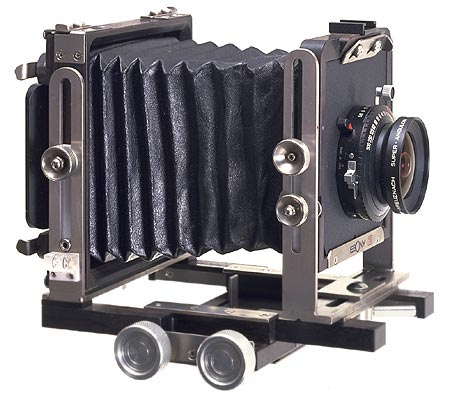Going big II: The 6x9 medium format view camera
In the dark ages before the prevalence of digital SLRs, there was a natural progression from 35mm to medium format for some types of photographers. My early photographic interest was primarily street photography, which meant 35mm rangefinders. I started with a Petri 7, moved up to a Canonet, and finally made the jump to a Leica when I got more serious. I also had Nikon film SLRs for some types of work.
After shooting a job with a rented Nikon D1X about 5 years ago, I realized the speed and economy of digital SLRs was a big advantage. Because I was interested in night and low light photography, I switched from Nikon film SLRs to Canon digital when the 10D came out.
I often shoot with two cameras at night, one film and one digital. Around the full moon, digital exposures are usually in the 3-8 minute range. Sometimes I'll shoot 15 minute exposures with the 5D for longer star trails. My strategy is usually to work the scene with 5-6 minute digital shots, and use a film camera for 20-30 minute exposures. I would really like to replace the $79 Voigtlander rangefinder I'm using with a medium format film camera. As a rangefinder fan who usually prefers small format focal lengths between 21-35mm, the best choices look like the Mamiya 7 or Fuji GSW690.
After years of shooting mostly 35mm, I'm most comfortable with the 1:1.5 aspect ratio. I've owned a twin lens reflex and Hasselblad, but I just don't see in squares. Medium format shooters have long pondered the format question: 645, 6x6, 6x7, or 6x9? For me it's between 6x7 and 6x9.
When you're shooting 20-30 minute or longer exposures, medium format is great because you'll shoot one roll in a night. A 6x7 camera is 10 shots on a roll of 120 film, 6x9 is 8 shots. With 35mm film it sometimes takes me 2 nights of shooting over two full moons to go through a roll of 36. I'm a reasonably patient guy, but waiting 9-10 weeks to see your photos is ridiculous.
If night photography didn't involve crawling around in some funky places, there would be an underdog contender for a medium format camera. I haven't had a bout of camera lust quite this bad in a long time. I tried not to look. I tried not to think about it. Blame it on Lance Keimig, who brought one to the Mono Lake Workshops this year. I want an Ebony SW23.
Ebony is a small Japanese large format camera company with a reputation for superb design and craftsmanship. The SW23 is actually a 6x9cm or 2x3" format camera with the movements of a view camera. The camera does not fold, making it light weight, and easy to setup. Optimized for wide angle lenses, focal lengths from 47-180mm can be used, which translates to about 20mm to 65mm in 35mm format.
Sounds expensive, right? The Ebony SW23 is $1995, about $500 less than a Canon 5D. Of course you still have to buy lenses and a film back. And I'd need to hire a bodyguard to take this camera on a night photography shoot. And it's challenging enough to frame your images at night, much less when they're upside down and backwards on the ground glass (you can also use a Horseman SW viewfinder).
But if you want to print large, consider these numbers: A 6x9 negative scanned at 4000dpi is about 9,400 x 14,000 pixels. A 300 dpi print is 30x45" without any interpolation. That's about 130 megapixels, or 10 times the Canon 5D. That's food for thought. To read more about Horseman and other choices in 6x9 medium format view cameras, have a look at this interesting thread on www.largeformatphotography.info.
